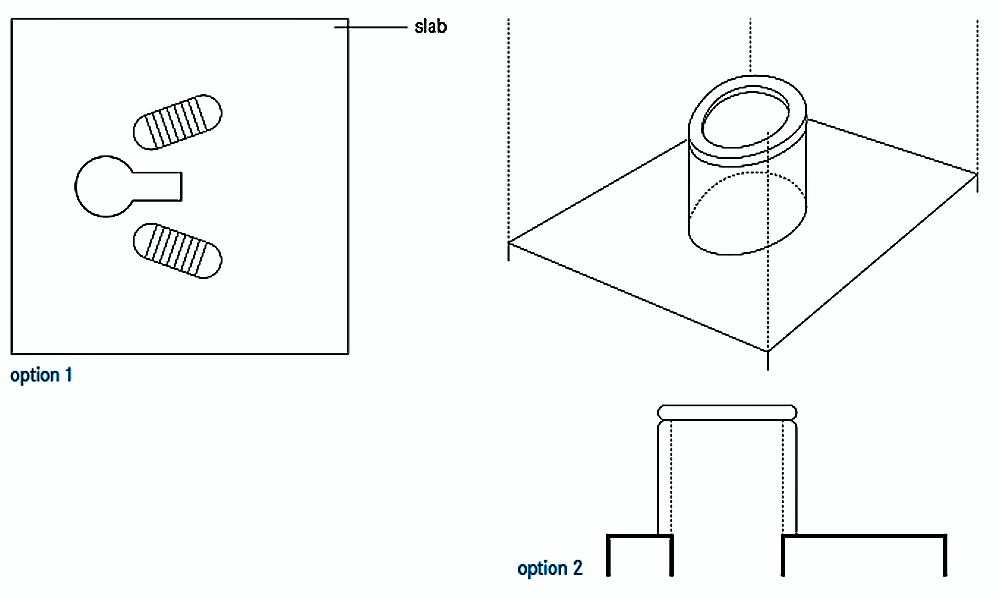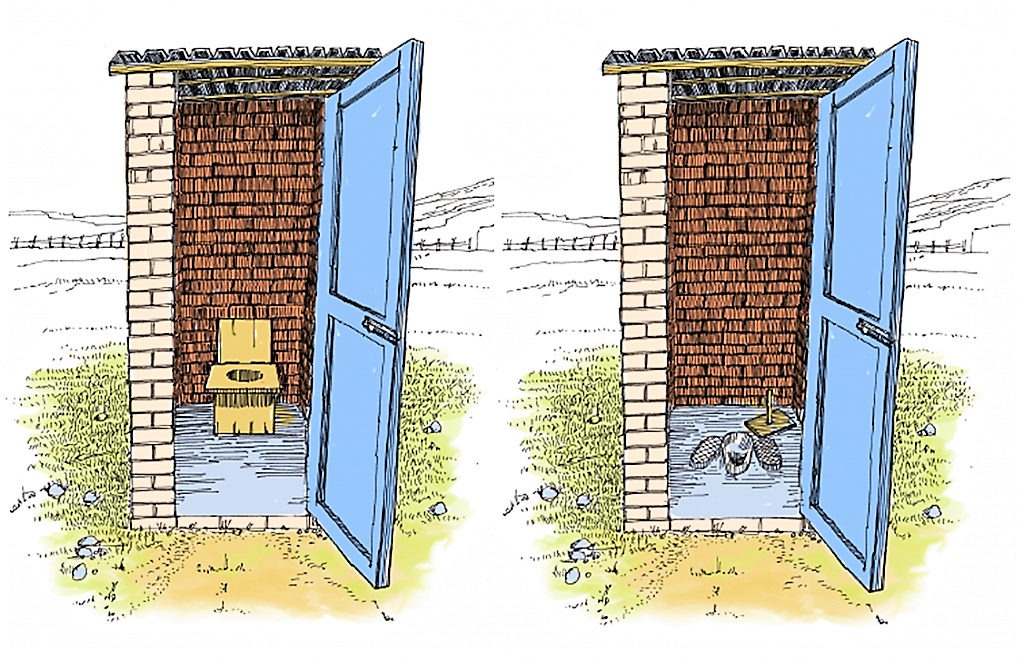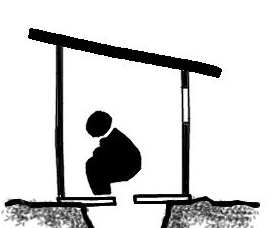Executive Summary
A dry toilet is a toilet that operates without flushwater. The dry toilet may be a raised pedestal on which the user can sit, or a squat pan over which the user squats. In both cases, excreta (both urine and faeces) fall through a drop hole.
| In | Out |
|---|---|
Urine, Faeces, Anal Cleansing Water, Dry Cleansing Materials |
Excreta, Anal Cleansing Water, Dry Cleansing Materials |
Introduction
Here, a dry toilet refers specifically to the device over which the user sits or squats. In other literature, a dry toilet may refer to a variety of technologies, or combinations of technologies (especially pits).

[/no-ecompendium]Design Considerations
The dry toilet is usually placed over a pit; if two pits are used, the pedestal or slab should be designed in such a way that it can be lifted and moved from one pit to another.
The slab or pedestal base should be well sized to the pit so that it is both safe for the user and prevents stormwater from infiltrating the pit (which may cause it to overflow) , see also stormwater management . The hole can be closed with a lid to prevent unwanted intrusion from insects or rodents.

Pedestals and squatting slabs can be made locally with concrete (providing that sand and cement are available). Fibreglass, porcelain and stainless steel versions may also be available. Wooden or metal moulds can be used to produce several units quickly and efficiently.
Health Aspects/Acceptance
Squatting is a natural position for many people and so a well-kept squatting slab may be the most acceptable option.
Since dry toilets do not have a water seal, odours may be a problem depending on the Collection and Storage/Treatment technology (see http://ecompendium.sswm.info/sanitation-technologies) connected to them (see also wastewater collection and wastewater storage and treatment) .
Operation & Maintenance
The sitting or standing surface should be kept clean and dry to prevent pathogen/disease transmission (see also pathogens and contaminants, water sanitation and health and health risk management) and to limit odours.
There are no mechanical parts; therefore, the dry toilet should not need repairs except in the event that it cracks. Click here for further information on operation and maintenance.
At a Glance
| Working Principle | Dry toilets operate without flushwater. The toilet can be a raised pedestal on which the user can sit, or a squat pan over which the user squats. Excreta (both urine and faeces) fall through a drop hole into a pit. |
| Capacity/Adequacy | Dry toilets are mainly suitable in regions where water is not easily available. |
| Performance | Easy to use for almost everyone, special considerations may need to be made for elderly or disabled users. |
| Costs | Low investment and operation costs. |
| Self-help Compatibility | Can be produced with locally available material. Operation is simple. |
| O&M | Sitting or standing surface should be kept clean and dry. |
| Reliability | High. |
| Main strength | Low-tech and no requirement of energy and constant source of water. |
| Main weakness | Odours are normally noticeable and excreta pile is visible, except where a deep pit is used. |
Dry toilets are easy for almost everyone to use though special consideration may need to be made for elderly or disabled users who may have difficulty. When dry toilets are made locally, they can be specially designed to meet the needs of the target users (e.g., smaller ones for children). Dry toilets are suitable for various cultural settings: they can be designed to suit both sitting and squatting cultures and to cope with the use of water for wet anal cleaning cultures as well. Because there is no need to separate urine and faeces, they are often the simplest and physically most comfortable option. Dry toilets are waterless systems that are particularly suitable for conditions where water is scarce or expensive.
Latrine Building
Introduction to Low Cost Sanitation Latrine Construction
This manual describes how to construct latrines.
CAWST (2011): Introduction to Low Cost Sanitation Latrine Construction. A CAWST Construction Manual. Calgary: CAWST URL [Accessed: 25.08.2014]Toilets That Make Compost
This book describes in an easy-to-understand and picture-based way how to construct three different low cost sanitation solutions, namely arborloos, fossa alterna and urine diversion toilets.
MORGAN, P. EcoSanRes (2007): Toilets That Make Compost . Stockholm: Stockholm Environment Institute URL [Accessed: 09.05.2019]Ecological Toilets
This book describes how to construct Arborloo toilets and how it can be upgraded to VIPs at a later stage.
MORGAN, P. EcoSanRes (2009): Ecological Toilets. (pdf presentation). Stockholm: Stockholm Environment Institute URL [Accessed: 09.05.2019]An Engineer’s Guide to Latrine Slabs
Providing sanitation for all is a major global challenge involving many complex issues. The user of a latrine however, will have more local concerns such as the condition of the latrine slab. This is one of the key components of the most common type of sanitary facility. This booklet highlights the design, manufacture and maintenance features that help to improve the safety and comfort of users.
REED, B. (2012): An Engineer’s Guide to Latrine Slabs. Leicestershire: Water, Engineering and Development Centre (WEDC) Loughborough University URL [Accessed: 08.10.2013]Compendium of Sanitation Systems and Technologies. 2nd Revised Edition
This compendium gives a systematic overview on different sanitation systems and technologies and describes a wide range of available low-cost sanitation technologies.
TILLEY, E., ULRICH L., LÜTHI, C., REYMOND P. and ZURBRÜGG C. (2014): Compendium of Sanitation Systems and Technologies. 2nd Revised Edition. Duebendorf, Switzerland: Swiss Federal Institute of Aquatic Science and Technology (Eawag) URL [Accessed: 03.05.2023] PDFCompendium of Sanitation Systems and Technologies (Arabic)
This is the Arabic version of the Compendium of Sanitation Systems and Technologies. The Compendium gives a systematic overview on different sanitation systems and technologies and describes a wide range of available low-cost sanitation technologies.
TILLEY, E. ULRICH, L. LUETHI, C. REYMOND, P. SCHERTENLEIB, R. ZURBRUEGG, C. (2014): Compendium of Sanitation Systems and Technologies (Arabic). 2nd Revised Edition. Duebendorf, Switzerland: Swiss Federal Institute of Aquatic Science and Technology (Eawag) PDFPathogens in Dry Sanitations Systems and Risk of Using Sludge Produced in Agriculture
A paper about the most common pathogens which exist in faecal sludge and how to control these.
JIMENEZ, B. NAVARRO, I. MAYA, C. (n.y): Pathogens in Dry Sanitations Systems and Risk of Using Sludge Produced in Agriculture. Mexico: University of Coyocan URL [Accessed: 06.10.2010]How to Select Appropriate Technical Solutions for Sanitation
The purpose of this guide is to assist local contracting authorities and their partners in identifying those sanitation technologies best suited to the different contexts that exist within their town. The first part of the guide contains a planning process and a set of criteria to be completed; these assist you in characterizing each area of intervention so that you are then in a position to identify the most appropriate technical solutions. The second part of the guide consists of technical factsheets which give a practical overview of the technical and economic characteristics, the operating principle and the pros and cons of the 29 sanitation technology options most commonly used in sub-Saharan Africa.
MONVOIS, J. GABERT, J. FRENOUX, C. GUILLAUME, M. (2010): How to Select Appropriate Technical Solutions for Sanitation. (= Six Methodological Guides for a Water and Sanitation Services' Development Strategy , 4 ). Cotonou and Paris: Partenariat pour le Développement Municipal (PDM) and Programme Solidarité Eau (pS-Eau) URL [Accessed: 19.10.2011]Smart Sanitation Solutions
Smart Sanitation Solutions presents examples of low-cost household and community-based sanitation solutions that have proven effective and affordable. A wide range of innovative technologies for toilets, collection, transportation, treatment and use of sanitation products that have already helped thousands of poor families to improve their lives is illustrated.
NWP (2006): Smart Sanitation Solutions. Examples of innovative, low-cost technologies for toilets, collection, transportation, treatment and use of sanitation products. (= Smart water solutions ). Amsterdam: Netherlands Water Partnership (NWP) URL [Accessed: 09.05.2019]Ventilation of dry toilets
This thesis aims at showing possibilities to improve ventilation standards of dry toilet facilities. Therefore, numerous structures were monitored over a period of three months, from March to June, in the southwestern districts of Uganda. The considerations and recommendations of this paper should support further development and improve future toilet structures in view of ventilation practices and design purviews. It should therefore contribute to a higher quality and acceptance of the dry toilets in the long term.
GROTH, F. (2005): Ventilation of dry toilets. (= Master Thesis ). Pinkafeld: Fachhochschulstudiengänge Burgenland GmbH URL [Accessed: 11.08.2010]Is it Time to kill off the Flush Toilet?
Critical article on the conventional flush-and-forget toilet systems on the occasion of the World Toilet Summit and Expo in Macau.
DUNCAN, D. (2008): Is it Time to kill off the Flush Toilet?. In: TIME.com: URL [Accessed: 10.08.2008]http://www.drytoilet.org/
The Global Dry Toilet Association of Finland collects and distributes information on different types of dry toilet solutions, develops dry toilet technology (DT-technology) and culture, promotes the use of dry toilets, looks after the interests of dry toilet users, organises exhibitions, conferences and other events, participates in research and publish research results, finds ways to solve problems regarding dry toilets and makes statements to the press and public regarding dry toilets.

